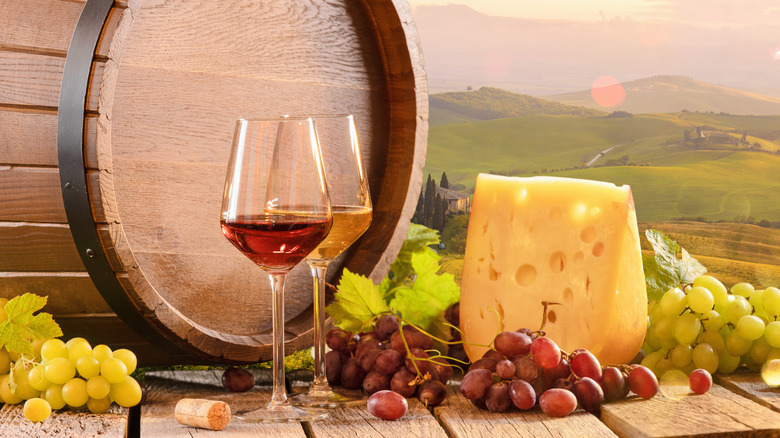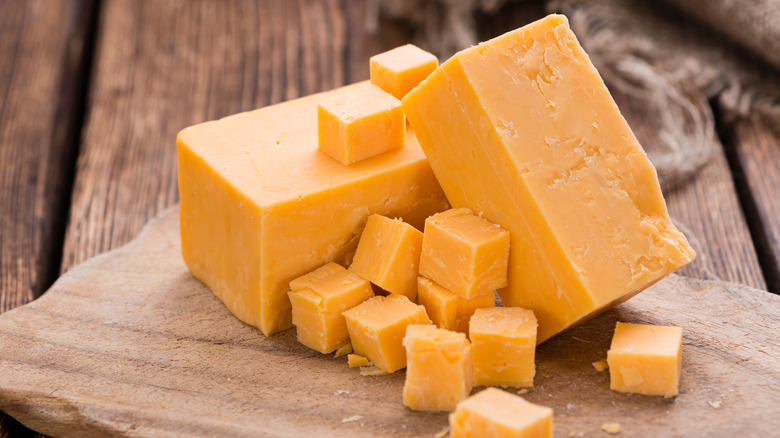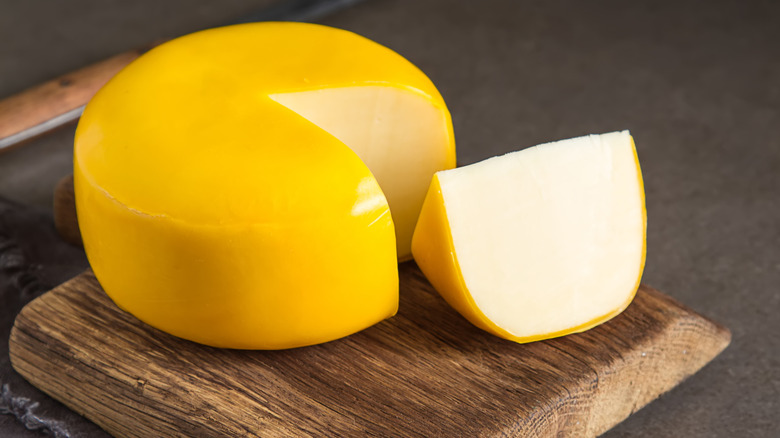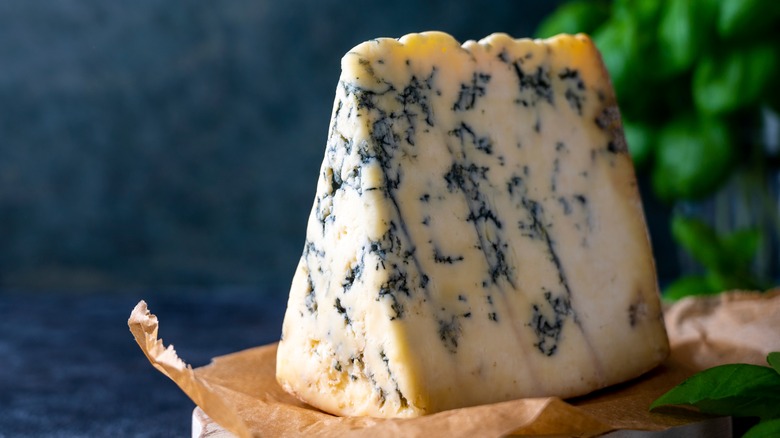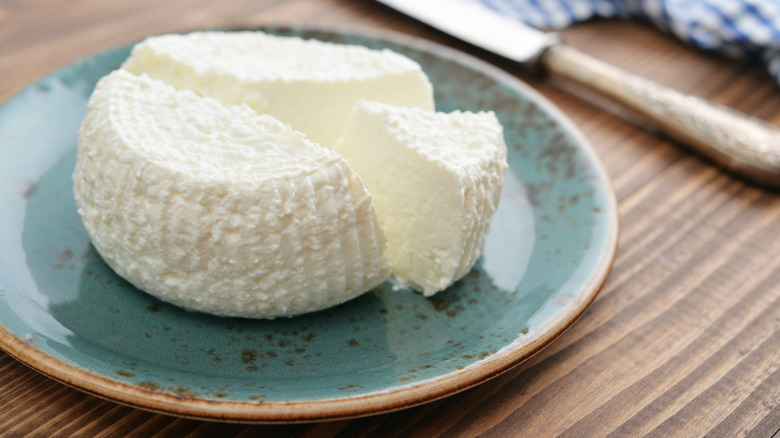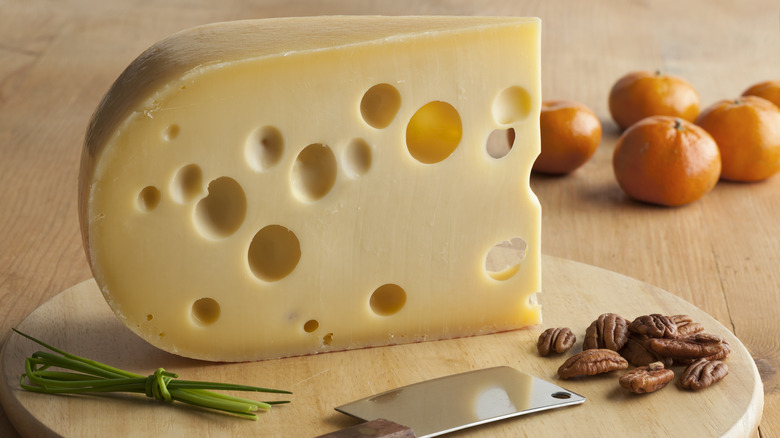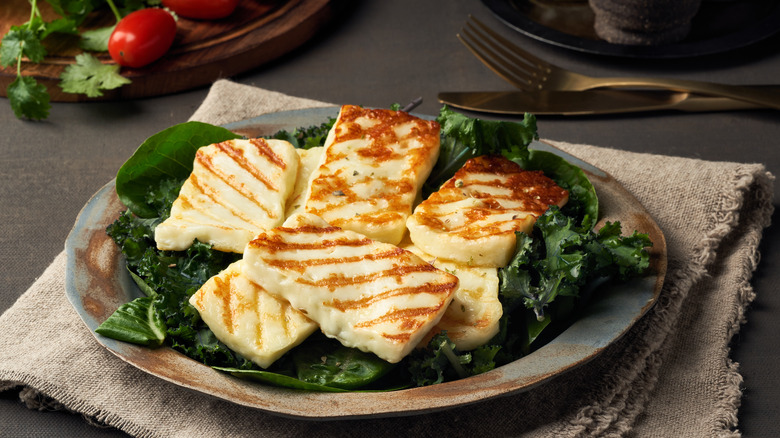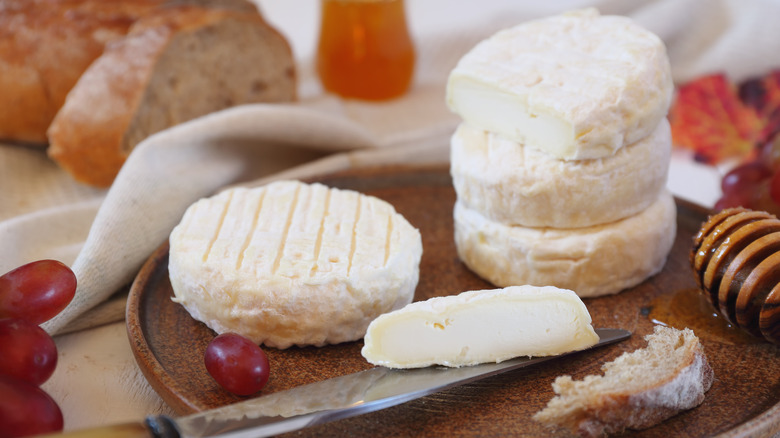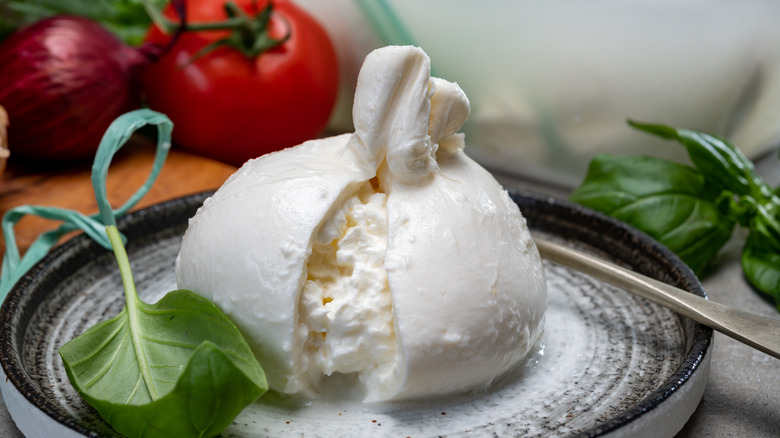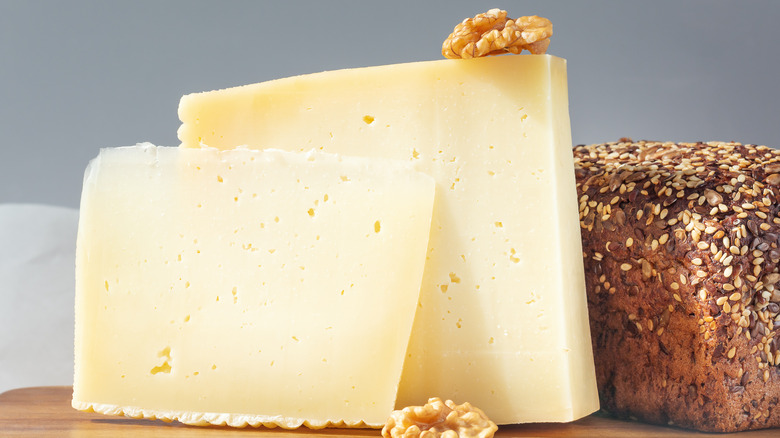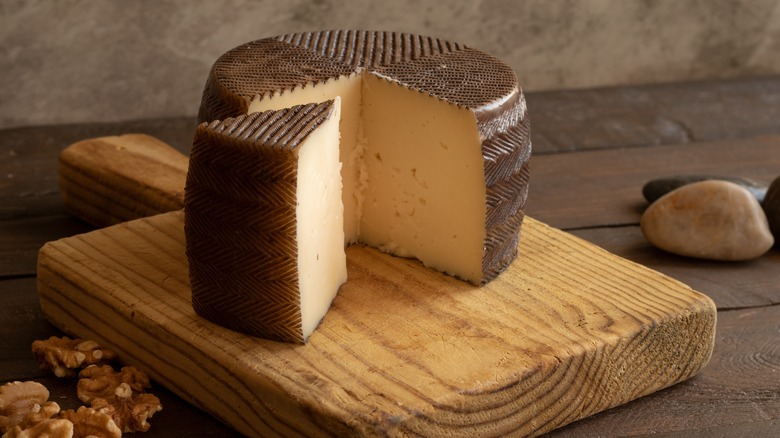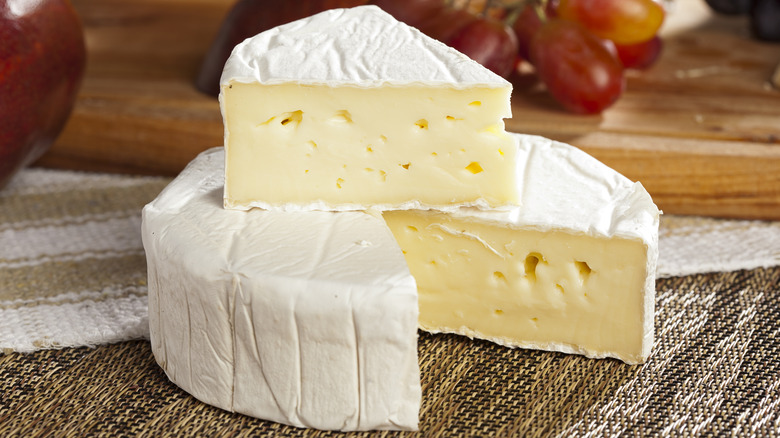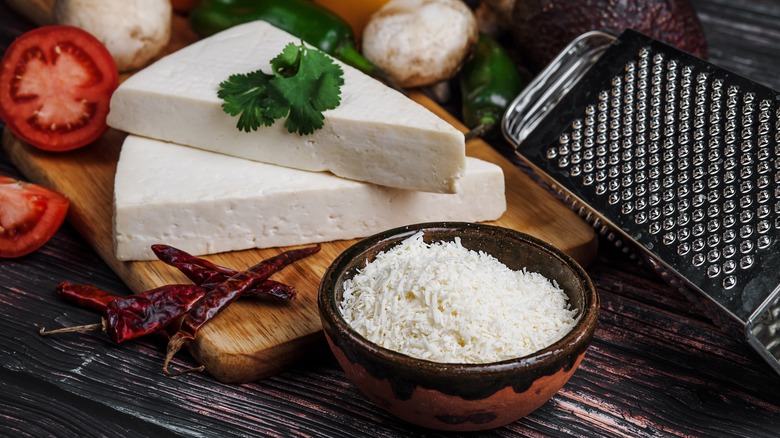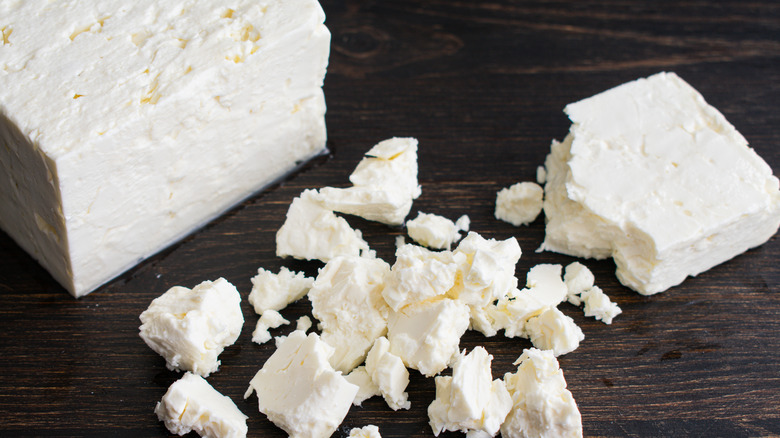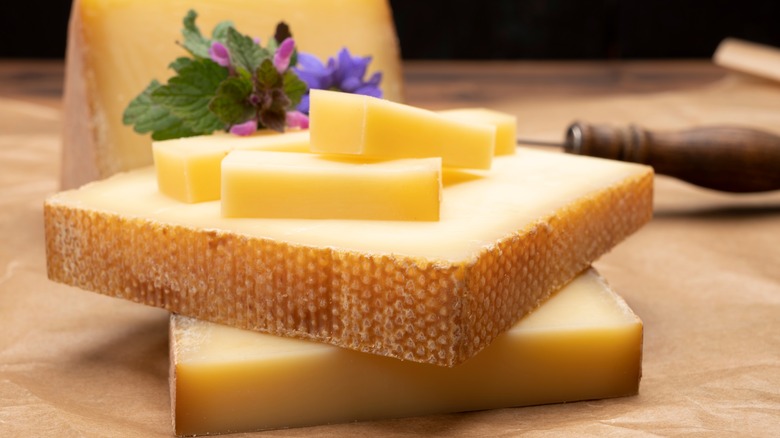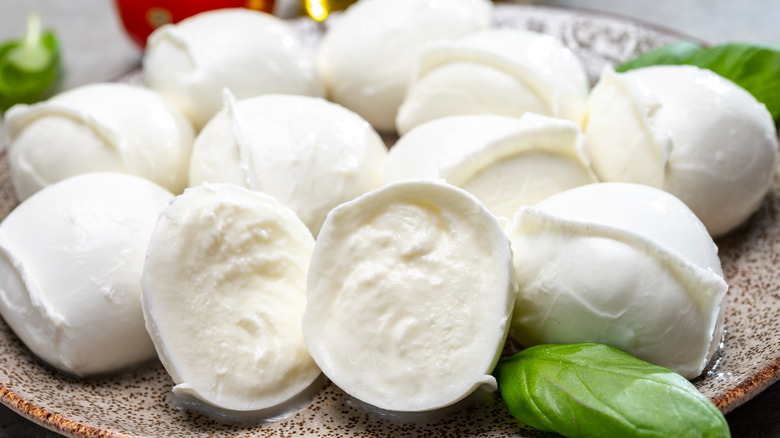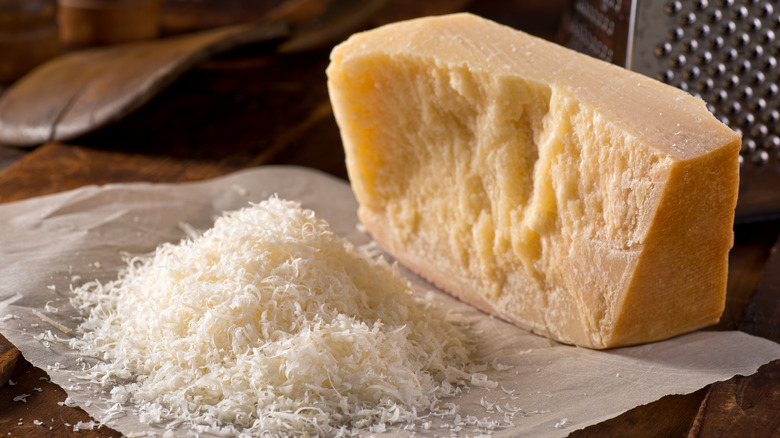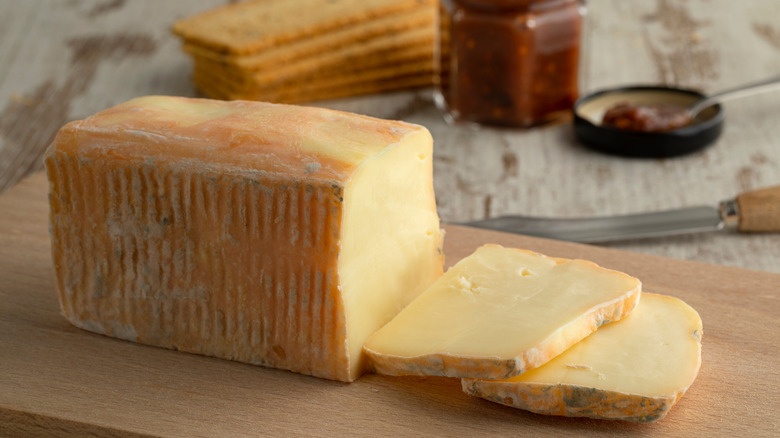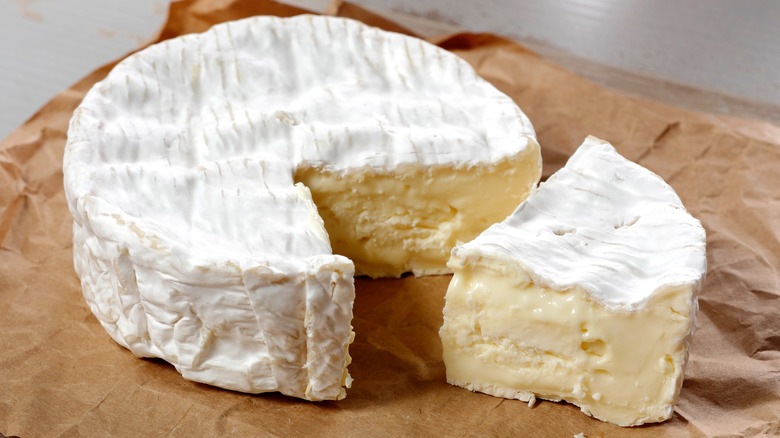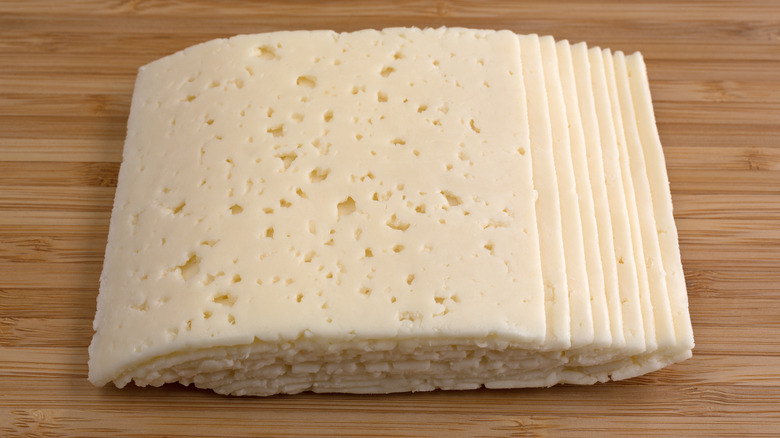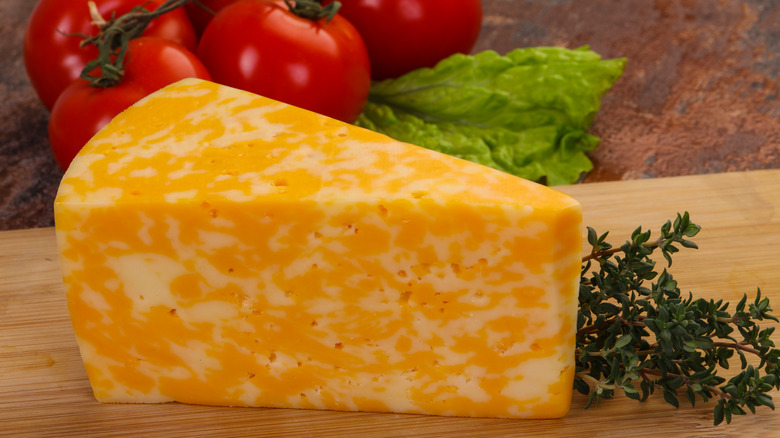The Best Types Of Wines To Pair With Cheeses
It's hard to find a more popular pairing than wine and cheese, and there's a reason why this twosome receives so much love. Given that both offer a near-endless variety of options for consumers, allowing them to share the stage is an epicurean avenue worth exploring.
As a consumer, it's especially exciting to taste the two in tandem. However, a wide range of flavor profiles are covered for both the cheese and wine categories, and finding the right pairing isn't as simple as mixing and matching based on broad distinctions such as white or red, hard or soft, and processed or pricey. There are a number of factors that go into bringing together the perfect duo. For example, while some wines will serve as a palate cleanser for a rich creamy cheese, others mingle seamlessly. If you don't know where to begin or are always reaching for the same reliable combo, get ready to experiment with novel flavors. Here are some wine and cheese pairings you should consider.
Cheddar
it's hard to go wrong with cheddar, so it's no surprise that it's the most popular cheese in the U.S., according to a 2021 poll by YouGov. Cheddar originally comes from its namesake region in England (via Britannica), however, if you're eating the American stuff chances are it was made in Wisconsin (via Dairy Farmers of Wisconsin). Whether you go for white, orange, mild, or sharp, this versatile cow's milk product is just as delicious melted in a grilled cheese sandwich or cubed as a quick snack.
Typically the flavor is quite salty, with milder notes in its youth and a sharper nutty bite as it ages. Earthy and tangy flavors are sometimes present, and many producers add additional ingredients like herbs or spices to create different profiles. Cheddar is a hard cheese but you'll enjoy creaminess in younger styles, whereas mature ones offer a crumbly crystallized structure (via Castello).
If you're going all out with the cheese board and a bottle of wine, do yourself a favor and pick up an aged cheddar. Paired with a bottle of Chilean cabernet sauvignon, the bold flavors are a natural match in intensity, with neither overwhelming the other. The wine displays notes of red and dark fruits, spice, and herbal aromas to complement and contrast with the cheese. Try a bottle of Cousiño-Macul Antiguas Reservas cabernet sauvignon and a hunk of sharp cheddar for a sensory treat.
Gouda
A punchy option, Gouda is a favorite among cheese lovers. The cheese comes from the Netherlands and is even named after a local town, though the name is not protected and can refer to a number of products (via Cheese.com). It can be made from cow, sheep, or goat milk, giving it a range of flavors.
There's a definite nuttiness to it, often paired with sweet notes and hints of caramel. Gouda is generally semi hard, though it can be more crumbly or smooth depending on its maturity. It slices well and is the perfect option for crackers and cheese.
Given its penchant for sweet, nutty, and bold flavors yet accounting for the fact that some types of gouda are simply mild and creamy, we're pairing it with a spicy syrah to contrast. Aromas of spices and herbs like pepper, rosemary, allspice, and cloves, mingle with smoky notes and ripe dark berries. Try a wine from the grape's homeland in France's Northern Rhône. For an excellent option that delivers on flavor, pick up a bottle of Crozes-Hermitage by E. Guigal, a top producer in the region.
Blue
Blue cheese tends to ruffle some feathers, creating a divisive line between those who love it and those who steer clear. It encompasses a large selection of cheese so if you're new to the style, it's worth experimenting with milder styles to build up your palate. The common feature between blue cheese varieties like Stilton, Roquefort, or Gorgonzola is the presence of a bluish mold that is marbled throughout, giving them their namesake color.
Most styles have a softer, creamy, or crumbly texture, with varying intensities in flavor depending on the specific spores and aging process. That being said, blue cheese is typically salty with a sharp pungent taste. Some lean toward nutty profiles while others border on tangy. Suffice it to say it rarely goes incognito.
Vintage Port undergoes its own aging regimen which paves the way for evolving aromas not present in the original fruit. Concentrated notes of chocolate, spices, dark berries, and nuts are displayed in this fortified wine. With its bold flavor, vintage Port stands up to the funky nature of blue cheese, complementing it with notes of spiced fruit. Pair your Stilton with a bottle of Quinta do Vallado Vintage Port for an affordable introduction to the style.
Ricotta
Although it's technically a dairy by-product and not exactly a cheese, ricotta easily fits into our selection. The Cheese Professor explains that it is made by cooking whey that remains after other types of cheese are produced. Although it was originally made to avoid waste, it has become a delicacy in its own right and is used in numerous preparations from lasagna to cheesecake.
The result is creamy and light, and perfect to spread on a cracker or piece of toast with jam. The flavor is generally quite mild but varies depending on the source of the whey (cow, sheep, goat, or buffalo). Plenty of artisanal variations are made, but you'll probably land upon a basic style if you're shopping at your local supermarket. You'll easily find it sold in a tub, but a cheese shop will probably also have fresh wheels available.
Since ricotta has a very subtle taste and a low-fat content, we're pairing it with a punchy flavorful wine. Lambrusco is a category of red wines from the northern Italian province of Emilia-Romagna that range from lightly bubbly (frizzante) to fully sparkling (spumante). It also comes in sweet, semi-dry, and dry styles, with flavor profiles encompassing red and dark fruits, cream, and floral aromas. To complement the delicate cheese, Lini 910's Lambrusco rosato offers up aromas of berries and cream with a pleasant mousse.
Emmental
Although the holey delicacy is widely known as Swiss cheese, it's actually named after its Swiss town of origin, Emmental, as Switzerland Cheese Marketing explains. Highlighting its key role in the country's dairy products, the outlet also gives it the title of the king of all cheeses from Switzerland. Varying with maturity, the hard cheese can display nutty or fruity flavors, bordering on pungent with older styles.
According to Culture Magazine, the iconic holes (aka eyes) develop as it ages due to bacterial activity that produces carbon dioxide. Temperature changes can affect the size and rate of their growth, and cheesemakers often experiment with these variables. It's worth fiddling with them because they ultimately affect the outcome of the flavor, which becomes stronger as the holes grow.
Pair this versatile cheese with an equally versatile wine: riesling. The grape can produce everything from sweet dessert wines to dry sparklers and anything in between. With its high acidity and pleasant aromas of citrus, stone fruit, green apple, and white flowers, it will suit both nuttier and fruitier styles of Emmental. We're opting for a dry riesling to match the flavor intensity of the cheese. Try a bottle of Nik Weis St. Urbans-Hof old vine riesling for a refreshing match.
Halloumi
This squeaky cheese from Cypress is a delicacy made by salting cheese curds, poaching them in whey, and brining them for a salty finish (via BBC Good Food). Standard cow, goat or sheep milk can be used, resulting in a medium-firm cheese typically sold in a block. You can eat halloumi straight up, but the true experience comes from grilling it. Thanks to its high melting point, the cheese develops a charred exterior and a chewy tangy center. It's delicious cubed and enjoyed as a savory snack or mixed into a fresh salad to balance the saltiness.
Given its briny flavors, halloumi pairs well with a high-acid mouth-watering white wine. Our top choice is albariño (or alvarinho if it's made in Portugal). This aromatic grape offers up similarly saline notes thanks to the influence of Spain's North Atlantic coast on the vineyards. You'll also get hints of citrus, stone fruit, honeydew, and variations in the body depending on the winemaking. Our top choice to pair with some grilled halloumi is an albariño from Bodegas La Caña in Rías Baixas, Spain.
Chèvre
Goat cheese is familiar yet just funky and varied enough to make it a great option for hesitant eaters. Although the label can be used to describe any cheese made with goat's milk, typically a young creamy style from France — chèvre (aka goat) — is the one that comes to mind. Rich and buttery with a subtle herbal aroma, this easily spreadable cheese is often enhanced with herbs or pepper for an added punch. Include it in a cheeseboard, toss it into a salad, or use it to give your homemade pizza a little extra pizzaz.
Goat cheese and sauvignon blanc wines often go hand in hand thanks to their similar herbal notes. While both come in a wide range of styles, Sancerre from France's Loire valley is a classic pairing. It makes sense once you learn that this area of France is renowned for its goat cheese, like Crottin de Chavignol (via Loire Chateaux). The zesty aromatic white wine is brimming with notes of gooseberry, grapefruit, hay, and flint — a regional touch. Pick up a bottle of Moulin des Vrillères Sancerre blanc by Domaine Lauverjat for a zippy palate cleanser to go with your cheese.
Burrata
Depending on where you live, mozzarella's fancy cousin burrata may have become a trendy buzzword in the last few years. The decadently creamy fresh cheese is a staple of restaurant menus and artisanal delis, and it's not hard to understand why. For starters, it presents quite a show when displayed in its full glory. The soft cow's milk cheese comes in a spherical shape, which consists of a mozzarella skin exterior typically knotted to contain the interior made of cheese curds and cream.
Burrata is a rich sensory treat, so you don't need much more than a drizzle of olive oil, crusty bread, and perhaps tomatoes with fresh basil if you want to add some food groups. To serve, make a slit in the casing to let the insides ooze out. As a star on its own, we recommend pairing it with a wine that complements the creamy texture without overpowering the delicate taste.
Being the leading region in the world for rosé wine, the dry Provence style is a favorite for many. These wines are blends that can include a number of grapes, leading to significant variations from one bottle to the next. Château de Berne's Romance rosé offers notes of orchard fruit, peach, and berries, with subtle floral aromas and a crisp finish, the perfect match for every creamy bite of burrata.
Asiago
Real Asiago is serious business — to be labeled as such the cheese must be made within a designated geographical zone, aka Asiago PDO. The two main styles are pressato or d'allevo (pressed or nurtured respectively). Both styles are semi-firm, and whereas the former has larger holes and a pleasantly subtle flavor, the latter features a grainier texture with small holes and a pungent taste.
The distinctions come down to the type of milk used (pasteurized versus raw) and the maturation process. The mild taste of pressato can be explained by its minimal aging (about one month), while Asiago d'allevo can sit around for 15 months or more, developing novel aromas over time.
Given its range of flavors, it's worth pairing Asiago with a versatile wine like pinot noir. Depending on its growing region and winemaking techniques in the cellar, pinot can showcase aromas that range from fruit-forward to earthy. To pair with sweeter styles of Asiago and those with more savory flavors, a fruity style of pinot noir is our top choice. Try Dashwood pinot noir from New Zealand's Marlborough region for a smooth and balanced option brimming with berries and dark cherry.
Manchego
Named after its region of origin in La Mancha, Spain, Manchego is a medium-hard cheese made from local sheep milk (via Castello). The flavor profile offers pleasantly nutty and fruity aromas, with an herbal characteristic that may very well bring to mind grazing sheep. According to Cheesemaking.com, the rind's notable zigzag pattern is a result of the traditional grass casing used to shape the cheese during production. As the cheese matures, so does its flavor and aged versions will even display a crystallized texture. Manchego is a great option if you're looking to venture into bolder styles of cheese.
Similarly, skin-contact or orange wine requires a leap of faith for some consumers, yet the endless variety of choices means you're sure to find something you like. These wines are made by using white grapes vinified like red grapes (with the skins on). The process gives more structure, tannin, and fragrance in varying degrees depending on the duration of contact between the grape skins and juice. Start with a bottle of Skins by Field Recordings, a pleasant blend that displays notes of orange peel, tea leaves, and spice.
Brie
This popular cheese named after a region in northern France is the ultimate in decadence. The soft rind hides a smooth creamy interior, which varies in gooeyness depending on the fat content, indicated by the double or triple cream label (via The Cheese Empire). The real deal is made with unpasteurized cow's milk, but variations with sheep or goat milk are produced as well (via iGourmet). Given its traditionally unpasteurized nature, the Brie exported to the U.S. is milder than the authentic version.
Although the rind is edible, if you're still developing your palate for fine mold, you're welcome to stick to eating the creamy insides. The flavor profile displays notes of butter, cream, nuts, fruit, and mushrooms, which taste equally delicious fresh or heated. If you want to experiment beyond eating a hunk of brie with bread, bake a wheel in pastry crust for a truly epicurean feast.
This buttery cheese practically screams for bubbles, and while Champagne is often touted as its ideal counterpart, we'll let you in on a secret. You don't have to splurge on the big name to get something equally delicious, produced according to the same method, using the same grapes. Crémant de Bourgogne is a sparkling wine made in Burgundy (just south of the Champagne region) using pinot noir, chardonnay, and occasionally small quantities of other local grapes. Our favorite is Bailly-Lapierre Crémant de Bourgogne Réserve Brut, a fresh and aromatic option that will clear your palate for the next bite.
Cotija
Many classic types of cheese tend to come from Europe, but Cotija hails from just south of the border. This Mexican cheese takes the name of its hometown and is quickly becoming a household name in the U.S. The texture is fairly crumbly and softens as it warms up, making it an excellent ingredient to use as a garnish.
Given its salty nature (its most notable feature), Cotija infuses a little punch of flavor to other dishes, which could be overpowering if consumed solo. This characteristic has earned it the title of Mexican Parmesan. Try it on grilled corn, a common street snack locally known as elote, or add it to the condiments spread on your next taco or burrito night.
To balance out the salt, we're pairing Cotija with a fruit-forward Beaujolais wine made with gamay grapes. Nouveau styles are especially fruity due to their youth, whereas Villages or Cru level wines offer a little more complexity. Try Domaine Bertrand's Vuril from the Brouilly Cru for a wine featuring red fruits, stone fruit, and a gentle acidity with smooth tannins.
Feta
Feta is another consumer favorite, and the salty cheese has long been winning hearts far beyond its homeland of Greece. Although various brined products with similar results are made around the world, the original source is from the Mediterranean country. Indeed, the Feta PDO guarantees a product is made with sheep milk (sometimes combined with goat milk) in a specific region in Greece, following traditional methods that date back many centuries.
The crumbly briny cheese is famously present in Greek salad recipes, but its consumption shouldn't end there. Whip it into a creamy dip, slice it thick for a sandwich, sprinkle it over pizza or pasta dishes ... the options are endless.
The salty flavor calls for a refreshing high-acid wine, and another Greek favorite is our choice. Assyrtiko is one of Greece's top white wine grapes, particularly prevalent on the island of Santorini. It's everything you would want from an island wine: crisp, zingy, with lemon, lime, and mineral notes. It features just enough salinity to emphasize the briny cheese, resulting in a true match. Pick up a bottle of Monograph by Gaia Wines for a pairing you won't forget.
Gruyère
Believe it or not, Swiss Gruyère cheese has been made since the year 1115. That's a long time to master a method, and the tradition is evident in the complex flavor. From the cow's diet to the curdling process, leading to a salt bath and ultimately maturation in cellars, every step of Gruyère's production is controlled according to the PDO regulations.
While basic styles cap off at nine months of aging, 24 months yields an even bolder taste. Depending on the age, flavors range from creamy and fruity to nutty and earthy, with varying degrees of intensity. Enjoy the semi-hard cheese solo or with accouterments on a cheese board, melt it on a gratin, or savor it in its full glory as fondue.
Gewürztraminer grapes produce floral aromatic wines often brimming with flavors of rose, Turkish delight, tropical fruit, and spices. Although the grape originates in the vicinity of Switzerland, it is increasingly planted worldwide. Taste how it fares grown in the U.S., with a bottle of Hyland Estates old vine gewürztraminer from Oregon's Willamette Valley.
Mozzarella di Bufala
Who doesn't love a classic mozzarella di bufala? The creamy melt-in-your-mouth cheese is the star of Caprese salads, but it can just as easily garnish a pizza or veggie sandwich. Not to mention, solo with a drizzle of olive oil, sprinkling of salt, and crusty bread should satisfy any cravings.
Mozzarella di Bufala Campana PDO is the O.G., and it's guaranteed to be made in the Southern province of Campania with fresh milk from water buffalos. The soft cheese has a delicate flavor with a hint of tanginess. You can buy it in large spheres or in smaller balls known as bocconcini. Some cheesemakers will smoke it, infusing it with a bolder flavor and aroma.
This pleasant fresh cheese deserves a wine to match its subtle nature. Bardolino Chiaretto is a rosé wine made from local grapes around the Garda Lake in the north of Italy. Fruity and bright, these wines pair well with lighter dishes like salads, notably a Caprese. Citrus, stone fruit, and floral aromas are present in this light-bodied wine that will whisk you to a sunny patio. Enjoy a bottle of Corte Gardoni Bardolino Chiaretto for a refreshing complement to mozzarella di bufala.
Parmesan
This deliciously umami-packed cheese has been imitated to no end, but the real deal stuff from Parma, Italy, is Parmigiano Reggiano. It's been produced in the region for the better part of a millennium, resulting in a cheese that can never truly be replicated (though that doesn't stop counterfeiters across the globe).
Due to the consistency and hard nature of Parmesan, it comes off in chunks rather than slices. While you can nibble on it solo as a salty snack, it truly shines as a garnish for savory dishes. Grate it on pasta, crumble it over salads, or shave it over a fresh plate of beef carpaccio. Any which way, the subtly sweet, salty, and herbal flavors will enhance the other ingredients.
Pair this iconic Italian cheese with an equally iconic wine: Chianti. Made primarily from sangiovese and small quantities of local grapes, this Tuscan wine has been a crowd favorite for centuries. The wines offer bold red fruit aromas, herbal notes, smokiness, and hints of tobacco. The balanced acidity is a great match with Parmesan. Pick up a bottle of Volpaia Chianti Classico for a noteworthy example of the style.
Taleggio
If you're searching for more soft cheeses to add to your repertoire, then look no further than Taleggio, a PDO cheese from Italy (via iGourmet). You'll likely have to bypass the supermarket and head straight to the cheese store to find this delicacy in the U.S., but it's well worth the detour. Mild, yet fruity and slightly tangy, this buttery cow's milk product is a treat. The odor is notably more pungent than the flavor, so you'll have to trust us and dive right in.
While this tasty cheese is well-suited for a cheese board, it also melts with ease, making it a great ingredient to add to a simple polenta recipe or basic grilled cheese sandwich. However you eat it, wines made with barbera grapes are the perfect counterpart. Smooth, bold, and teeming with ripe flavors of cherries, dark berries, and plums, these subtly spiced licorice-tinged wines are rich yet highly palatable — not unlike Taleggio. Giovanni Rosso is a family-owned winery in Piemonte, and the Barbera d'Alba DOC Donna Margherita wine is an obvious winning combination.
Camembert
If your ooey gooey cheese preference lies in France, you can't miss out on a giant hunk — or better yet, wheel — of Camembert. Named after its region of origin in Normandy, this cow's milk cheese can easily be confused with Brie at a quick glance (via Britannica). The authentic version is made with raw milk, according to Cheese Grotto, however, pasteurization is required in the U.S.
Through a salting and ripening process, Camembert develops a bloomy rind which adds complex aromas. The cheese has an undeniably buttery flavor, with subtle sweet creamy notes and varying intensities in taste as it ages. It's perfect on a cracker or nestled between two slices of bread in a sandwich. As with Brie, if you want to go all out then wrap it in a flaky pastry and bake it until the center oozes.
Camembert is rich so if you want to keep savoring each bite, do yourself a favor and pair it with a high-acid white wine. Chenin blanc is our top choice thanks to its balanced acidity and complex aromas. Tree fruit, honeysuckle, ginger, and brioche notes are just a few of the flavors present in these multifaceted wines. Try Badenhorst Sécateurs chenin blanc from South Africa, where the grape is locally known as steen.
Havarti
Although havarti is a popular cheese stateside, it is actually a Danish export (via Shishler Cheese House). The delicacy comes in various styles, from creamier ones made with pasteurized milk to semi-firm cheese with eyes. Aging also influences the flavor and consistency, ranging from fruity and mild to nutty and salty.
Additionally, manufacturers love infusing the mild cheese with ingredients like black and red peppers, chives, and jalapeños. It's commonly sold pre-sliced, making it a simple addition to sandwiches, however, it's worth trying it in block form to savor its consistency. It also melts easily, making it a versatile option in the kitchen.
Since havarti doesn't overwhelm the palate, give it a boost with a full-bodied white wine. Viognier grapes display flavors of stonefruit and flowers, with a notable perfumed presence that sets it apart. These wines are typically rich and luscious, making them an ideal match for the semi-firm cheese. Pair your next havarti tasting with a bottle of Yalumba Y Series viognier from Australia.
Monterey Jack
It's no surprise that Monterey Jack is one of the top 10 most popular kinds of cheese in the country (via Taste Atlas). Commonly sold shredded, it's a popular garnish for Mexican and Tex-Mex dishes such as hard-shell tacos and nachos. The texture is fairly firm yet the balanced fat content makes it an easy cheese to melt, grate, or nibble on.
Flavorwise, there's nothing hugely unexpected or surprising about it, and the buttery taste makes it an easy win no matter the palate. To take it up a notch, producers regularly add herbs or spices, further increasing its versatility.
This American cheese needs an American wine, and although zinfandel did not originate in the U.S., California arguably put it on the map. Ripe jammy fruits mingle with warm spices, oak, vanilla, and tobacco notes in this medium-bodied flavor-packed wine. Try a bottle of Decoy zinfandel for a nuanced pairing with Monterey Jack.
